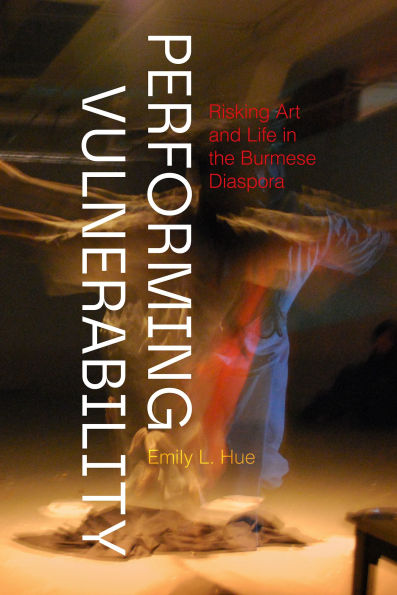The clash between an exile community making art and the expectations of others
A groundbreaking exploration of how diasporic Burmese artists navigate the intricate intersections of art, politics, and humanitarianism, Performing Vulnerability delves into the complexities of vulnerability as both a personal and a performative act. These diasporic artists, exiled due to state repression and political turmoil, find themselves in a precarious balance between expressing their traumas and engaging with the international art market’s expectations. They use their bodies as canvases to communicate the scars of surveillance, imprisonment, and censorship inflicted by their home state while simultaneously confronting the commodification of their suffering by global humanitarian industries.
Through their performances, these artists challenge the traditional narratives of victimhood and resilience, offering a nuanced portrayal of what it means to live and create in exile. Their work disrupts the easy consumption of suffering, instead inviting audiences to sit in the discomfort of these lived realities. Performing Vulnerability not only provides a critical examination of the economic and social value placed on representations of suffering but also opens a dialogue on the ethical implications of this value within the global arts and humanitarian markets. It is a vital contribution to discussions on diaspora, performance studies, and the politics of humanitarianism, offering a fresh lens through which to view the entangled relationships between art, suffering, and survival.
1146441803
A groundbreaking exploration of how diasporic Burmese artists navigate the intricate intersections of art, politics, and humanitarianism, Performing Vulnerability delves into the complexities of vulnerability as both a personal and a performative act. These diasporic artists, exiled due to state repression and political turmoil, find themselves in a precarious balance between expressing their traumas and engaging with the international art market’s expectations. They use their bodies as canvases to communicate the scars of surveillance, imprisonment, and censorship inflicted by their home state while simultaneously confronting the commodification of their suffering by global humanitarian industries.
Through their performances, these artists challenge the traditional narratives of victimhood and resilience, offering a nuanced portrayal of what it means to live and create in exile. Their work disrupts the easy consumption of suffering, instead inviting audiences to sit in the discomfort of these lived realities. Performing Vulnerability not only provides a critical examination of the economic and social value placed on representations of suffering but also opens a dialogue on the ethical implications of this value within the global arts and humanitarian markets. It is a vital contribution to discussions on diaspora, performance studies, and the politics of humanitarianism, offering a fresh lens through which to view the entangled relationships between art, suffering, and survival.
Performing Vulnerability: Risking Art and Life in the Burmese Diaspora
The clash between an exile community making art and the expectations of others
A groundbreaking exploration of how diasporic Burmese artists navigate the intricate intersections of art, politics, and humanitarianism, Performing Vulnerability delves into the complexities of vulnerability as both a personal and a performative act. These diasporic artists, exiled due to state repression and political turmoil, find themselves in a precarious balance between expressing their traumas and engaging with the international art market’s expectations. They use their bodies as canvases to communicate the scars of surveillance, imprisonment, and censorship inflicted by their home state while simultaneously confronting the commodification of their suffering by global humanitarian industries.
Through their performances, these artists challenge the traditional narratives of victimhood and resilience, offering a nuanced portrayal of what it means to live and create in exile. Their work disrupts the easy consumption of suffering, instead inviting audiences to sit in the discomfort of these lived realities. Performing Vulnerability not only provides a critical examination of the economic and social value placed on representations of suffering but also opens a dialogue on the ethical implications of this value within the global arts and humanitarian markets. It is a vital contribution to discussions on diaspora, performance studies, and the politics of humanitarianism, offering a fresh lens through which to view the entangled relationships between art, suffering, and survival.
A groundbreaking exploration of how diasporic Burmese artists navigate the intricate intersections of art, politics, and humanitarianism, Performing Vulnerability delves into the complexities of vulnerability as both a personal and a performative act. These diasporic artists, exiled due to state repression and political turmoil, find themselves in a precarious balance between expressing their traumas and engaging with the international art market’s expectations. They use their bodies as canvases to communicate the scars of surveillance, imprisonment, and censorship inflicted by their home state while simultaneously confronting the commodification of their suffering by global humanitarian industries.
Through their performances, these artists challenge the traditional narratives of victimhood and resilience, offering a nuanced portrayal of what it means to live and create in exile. Their work disrupts the easy consumption of suffering, instead inviting audiences to sit in the discomfort of these lived realities. Performing Vulnerability not only provides a critical examination of the economic and social value placed on representations of suffering but also opens a dialogue on the ethical implications of this value within the global arts and humanitarian markets. It is a vital contribution to discussions on diaspora, performance studies, and the politics of humanitarianism, offering a fresh lens through which to view the entangled relationships between art, suffering, and survival.
30.0
In Stock
5
1

Performing Vulnerability: Risking Art and Life in the Burmese Diaspora
316
Performing Vulnerability: Risking Art and Life in the Burmese Diaspora
316
30.0
In Stock

Product Details
| ISBN-13: | 9780295753614 |
|---|---|
| Publisher: | University of Washington Press |
| Publication date: | 06/10/2025 |
| Pages: | 316 |
| Product dimensions: | 6.00(w) x 9.00(h) x 0.00(d) |
| Age Range: | 18 Years |
About the Author
What People are Saying About This
From the B&N Reads Blog
